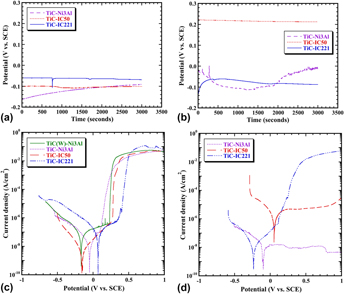Article contents
Factors influencing the aqueous electrochemical response of TiC–Ni3Al cermets
Published online by Cambridge University Press: 18 May 2017
Abstract

The aqueous corrosion resistance of TiC–Ni3Al based cermets was examined with the specific aims of assessing the influence of both the raw materials and the test methods, using a 3.5 wt% NaCl containing solution. The effects of W contamination in the ceramic phase was investigated using a single-phase ceramic, with and without W, and with a stoichiometric intermetallic Ni3Al binder. The influence of the electrolyte O2 content was examined for TiC cermets with 30 vol% binder, for both the stoichiometric composition and sub-stoichiometric variants, containing either Zr and B (alloy IC50) or Zr, B and Cr (alloy IC221) additions. Electrochemical measurements were matched with chemical and microstructural analyses at various stages of oxidation, and the rate of material loss in combination with the corrosion mechanisms were identified. The effects of O2 concentration were most significant for the TiC based cermets with Ni3Al due to the diffusion controlled nature of the reaction.
- Type
- Invited Articles
- Information
- Journal of Materials Research , Volume 32 , Issue 17: Focus Issue: Achieving Superior Ceramics and Coating Properties through Innovative Processing , 14 September 2017 , pp. 3333 - 3343
- Copyright
- Copyright © Materials Research Society 2017
Footnotes
Contributing Editor: Xiaowei Yin
References
REFERENCES
- 5
- Cited by





